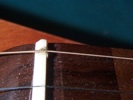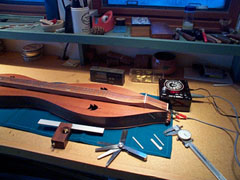Final Setup
Although its voice will continue to mature for some time to come, equipping with strings, intonation, and compensation are the luthier's final contribution of art to a stringed musical instrument's quality.
Intonation is the precise adjustment of the string ends with respect to the length and mass of the strings, location of frets, and height of the action Intonation is the final artistic act in the luthier's task. In intonating the instrument, we make extremely fine adjustments--usually to the saddle, but sometimes also to the nut--to bring the voice of the dulcimer into its final clarity. Compensation, the adjustment of the saddle to account for differences in string thickness, weight, and tension, is accomplished during intonation.
 Before we can address the issues of setting the action and intonation and compensation, we must decide on the strings to be used for the instrument. Many factors weigh on that choice, and the result can be critical to the instrument's performance. Here is a discussion of strings and how we them.
Before we can address the issues of setting the action and intonation and compensation, we must decide on the strings to be used for the instrument. Many factors weigh on that choice, and the result can be critical to the instrument's performance. Here is a discussion of strings and how we them.
 First, we set each string's action (height above the frets) at each fret. This will control the overall "feel" of the instrument in the player's hands. If the action is too high, the fingers must push too hard to get the string firmly fretted. If too low, the string will buzz against the frets. Between these two limits, one must take into account the personal taste and playing style of the person the instrument is being built for.
First, we set each string's action (height above the frets) at each fret. This will control the overall "feel" of the instrument in the player's hands. If the action is too high, the fingers must push too hard to get the string firmly fretted. If too low, the string will buzz against the frets. Between these two limits, one must take into account the personal taste and playing style of the person the instrument is being built for.
 Intonation itself is dependent on the setting of the action. So having set the action, we can now proceed to intonation. Briefly put, intonation consists of pushing the saddle back a precise amount to make it a little flat, so when you fret a string, thereby making it a little sharp, the result is precisely the tone you require.
Intonation itself is dependent on the setting of the action. So having set the action, we can now proceed to intonation. Briefly put, intonation consists of pushing the saddle back a precise amount to make it a little flat, so when you fret a string, thereby making it a little sharp, the result is precisely the tone you require.
 The last step is setting the saddle. This is a delicate, precise operation. It can only be done at the last moment. So we will be cutting into the finish of the fretboard, close to the visual focus of the whole instrument! Not a good place for sloppy work. The tension in the shop always goes up here...
The last step is setting the saddle. This is a delicate, precise operation. It can only be done at the last moment. So we will be cutting into the finish of the fretboard, close to the visual focus of the whole instrument! Not a good place for sloppy work. The tension in the shop always goes up here...
 After we have achieved a well-intonated instrument, it is time to tune the dulcimer, play it, and make some judgements about voice. One important matter of good voicing is to make sure the instrument had the right amount of sustain for the music to be played. Here's an article on methods for controlling for proper sustain.
After we have achieved a well-intonated instrument, it is time to tune the dulcimer, play it, and make some judgements about voice. One important matter of good voicing is to make sure the instrument had the right amount of sustain for the music to be played. Here's an article on methods for controlling for proper sustain.

